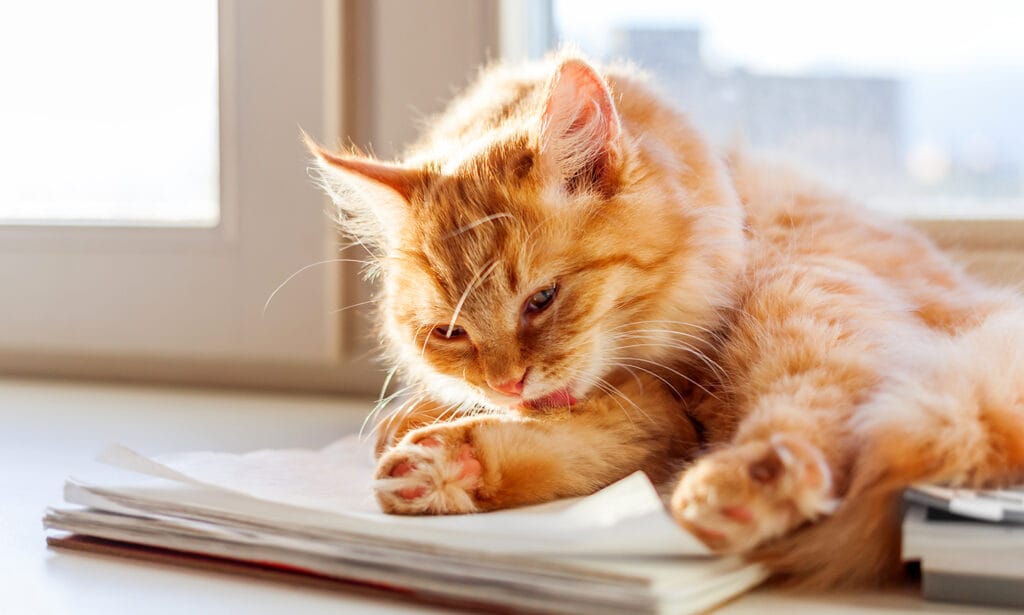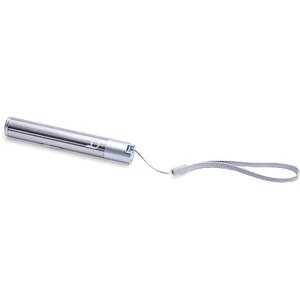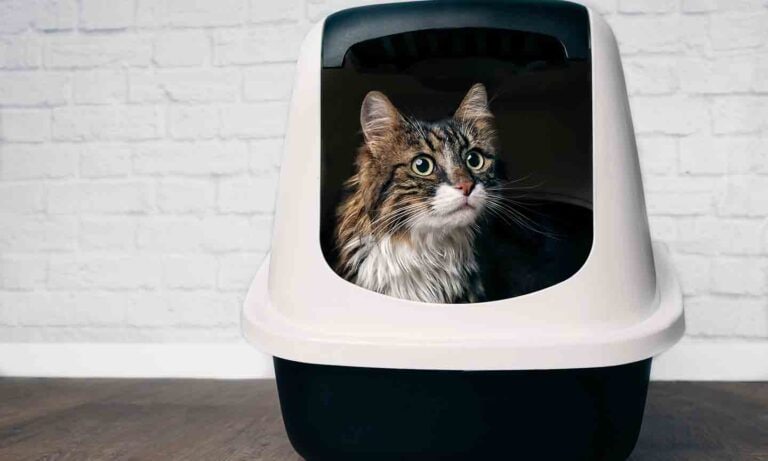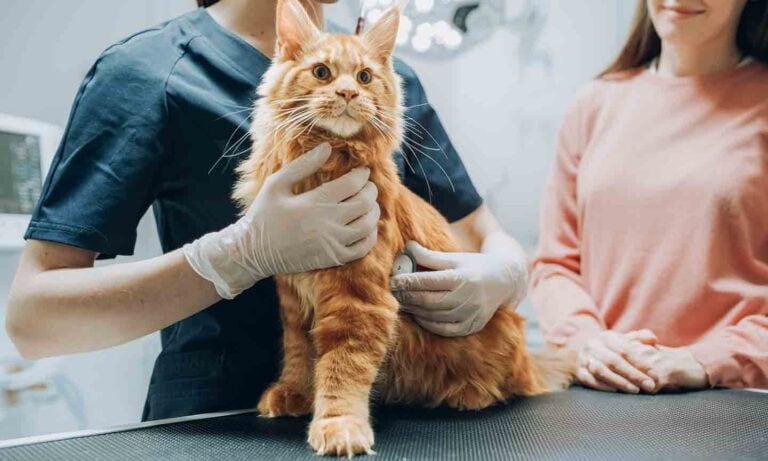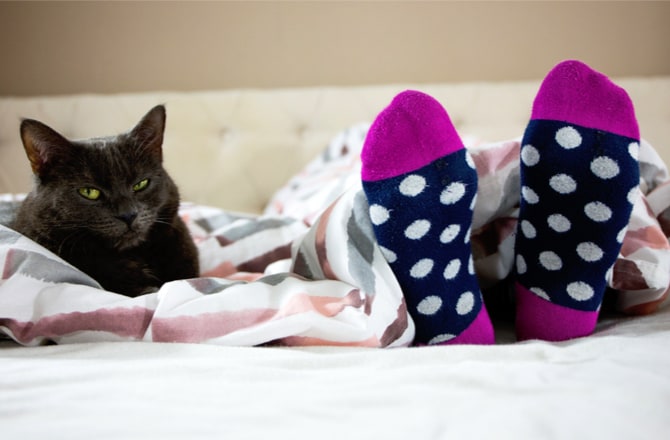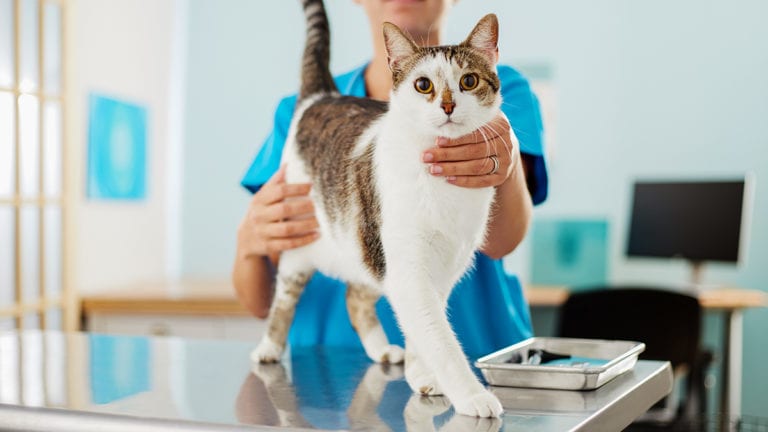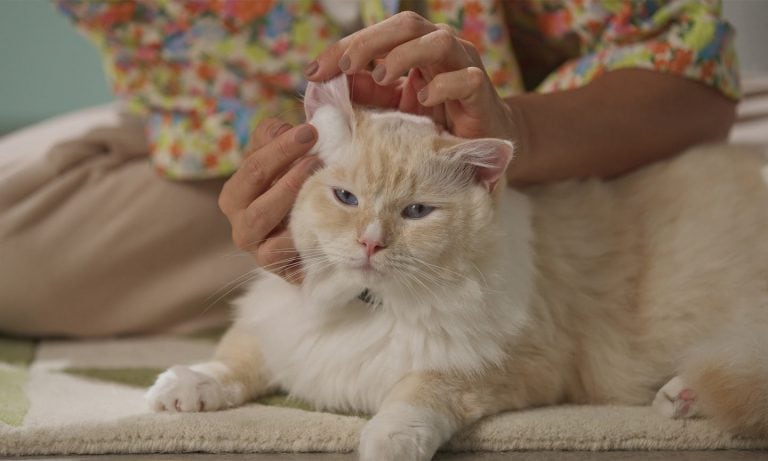When you imagine what your cat might be up to when you’re not home, it’s likely they’re either eating, sleeping, doing zoomies or grooming themselves. (OK, and maybe plotting.) With as much time as cats spend grooming and keeping up with their personal hygiene, it’s no wonder some of them have such a luscious, shiny coat. Our kitties nibble, bite and lick themselves as part of their regular routine, primarily to stay clean and cool, as well as to bond with their fellow four-legged friends and humans. However, it can be alarming to see them pulling their hair out, especially if it’s to the point where they’re missing big tufts of hair.
So, what do you do when you notice your cat pulling hair out? And why are they doing it?
We spoke to vet experts to learn why they do it, what to do about it, how to treat it and ways to prevent it.
How to Help a Cat Pulling Hair Out
Click to jump to each section.
Why Is My Cat Pulling Their Hair Out?
“Feline psychogenic alopecia—or excessive grooming and hair pulling—can occur in cats of any breed, age or gender,” says Dr. Alejandro Caos, DVM, a veterinarian with The Vets in Miami, Florida. “However, the prevalence of this behavior varies widely among individual cats. Some cats may never engage in excessive grooming, while others might be more prone to it due to various factors.”
There are several reasons why cats might be pulling their hair out, ranging from stress, anxiety and boredom to medical conditions, like allergic reactions, fungal infections and genetics.
Most Common Reasons for Cats Pulling Their Hair Out
Stress and Anxiety
These are the most common reasons why cats overgroom, according to Dr. Bethany Hsia, DVM, co-founder of CodaPet in Clovis, California.
“Cats may feel overwhelmed by sudden changes in their environment, such as a new pet or person in the house, or a move to a new home,” she explains. “When cats feel stressed, they may resort to self-soothing behaviors, like pulling out their hair.”
Boredom
Boredom is also a common reason. Mental and physical stimulation are essential for a happy, healthy kitty. But some cats, especially indoor cats, may not get as much enrichment in their daily lives as they need. This can lead them to engage in destructive behaviors that appear as feline trichotillomania (another term for extreme hair-pulling behavior), Dr. Hsia says.
Medical Issues
Some medical issues may also cause cats to pull their hair out. According to Dr. Hsia, they include:
- Flea infestations
- External parasites (e.g., mites and lice)
- Skin infections (due to bacteria, fungi or parasites)
- Allergies (e.g., food allergies, seasonal allergies or environmental allergies)
- Hormonal imbalances (due to hyperthyroidism or Cushing’s disease)
- Pain (due to arthritis or injury)
Less Common Reasons for Cats Pulling Their Hair Out
Genetics
Though less common, genetics can play a role in stress-related behaviors, including excessive grooming.
Some cat breeds, such as Siamese, are believed to be more predisposed to these behaviors, though not all cats of these breeds will engage in excessive grooming, Dr. Caos notes.
“Regardless of breed, any cat experiencing stress, anxiety or physical discomfort could potentially exhibit this behavior,” he says.
Disorders, Skin Conditions and More
Other less common reasons that could explain why a cat may pull their hair out include:
- Psychological disorders (e.g., obsessive-compulsive disorder (OCD) or other behavioral issues)
- Allergic dermatitis
- Neurological disorders
- Skin conditions (e.g., feline eosinophilic granuloma complex or pemphigus foliaceus)
- Autoimmune disorders
- Sensory issues
If you notice that your cat is overgrooming and/or experiencing hair loss, contact your veterinarian. They’ll be able to examine your cat, determine the underlying cause and develop a treatment plan.
What Is Psychogenic Alopecia in Cats?
Psychogenic alopecia (meaning “psychologically caused hair loss”) is a condition in which cats pull out their own hair, often due to stress, anxiety or boredom, Dr. Hsia says. If there have been any major—or even minor—changes in your cat’s routine, it’s possible this is the trigger behind their overgrooming.
The signs associated with psychogenic alopecia can appear similar to other conditions, but the biggest differentiator is that psychogenic alopecia is self-induced.
Symptoms of Psychogenic Alopecia
Unlike other medical conditions, psychogenic alopecia is a displacement behavior—meaning behavior that is often exhibited in response to emotional stress or conflict, rather than being solely caused by physical or physiological factors.
Common signs of psychogenic alopecia include:
- Hair loss or increased shedding
- Bald spots or bald patches
- Skin irritation (e.g., lesions)
- Redness on affected area
- Thinning of hair
- Skin infections
While cats can excessively groom certain areas, like their sides or near their belly, they may pick any area of their body to pull hair from. You may notice them coughing up more hairballs due to the amount of fur they’re pulling out.
How Psychogenic Alopecia Is Diagnosed
Psychogenic alopecia can be difficult to diagnose because it can be caused by a variety of factors, Dr. Hsia explains. If your cat’s showing signs of what appears to be psychogenic alopecia, it’s best to consult your vet.
During your visit, they’ll likely perform a physical examination and take a complete medical history to rule out other possible causes of your cat’s hair loss. They may also perform blood work tests and skin scrapings to eliminate any other potential conditions, such as bacterial infections, ringworm, flea allergies, etc., to determine a diagnosis.
How To Treat Cats Pulling Their Hair Out
“Treating trichotillomania in cats requires a multifaceted approach that includes environmental changes, behavior modification and medication,” Dr. Hsia says.
The first step in treating this condition is identifying and addressing any possible stressors or triggers in your cat’s environment. This could be reducing noise levels, playing calming music when you’re away or creating a zen space for them to get some R&R.
Another treatment involves changing your cat’s compulsive behavior through desensitization (slowly exposing a cat to something they fear to reduce the severity of their reaction to it) and counterconditioning (learning to associate something they fear or dislike with a positive outcome, like praise or treats). With this kind of training, you’ll gradually expose your cat to the stimuli that triggers their hair-pulling behavior and pair it with positive reinforcement (aka plenty of positive talk and treats!). Not only can this help modify their behavior, but it can also reduce the stress they associate with the trigger, making for a happier and more relaxed feline friend.
Depending on the severity, Dr. Hsia says medication may be necessary in some cases to properly treat your cat’s trichotillomania. However, it should always be used under your vet’s guidance.
Home Remedies for Cats Pulling Their Hair Out
Dr. Hsia says that although there aren’t any specific home remedies proven to treat this behavior, there are some things you can do at home to help manage it.
However, always consult with your veterinarian before starting any home remedies or treatments to ensure they are safe and appropriate for your cat’s specific condition, Dr. Caos says. “Your veterinarian can provide tailored advice based on your cat’s health status and the underlying cause of their excessive grooming,” he adds.
According to our experts, the following may help your cat if they’re pulling their hair out, depending on the underlying cause:
- Stress reduction. Some peace and quiet can go a long way for your kitty. By creating a restful, low-stress environment, they can retreat and relax. Pheromone diffusers by Feliway and calming collars may also help reduce your cat’s stress and anxiety.
- Regular grooming. By removing loose fur through frequent brushing, you can reduce the amount of hair your cat ingests while grooming themselves. Dr. Caos recommends using a soft brush that suits your cat’s fur type to prevent skin irritation. You can also take them to a groomer.
- Environmental enrichment. Cats love—and need—various forms of entertainment to put their mind and body to good use. Interactive toys and puzzle feeders can do just that. Scratching posts and pads are also great to satisfy their natural instincts. Additionally, distraction toys, such as laser pointers, can help redirect your cat’s attention away from the hair-pulling behavior, Dr. Hsia says.
- Dietary changes. If you suspect your cat has allergies, it’s worth reaching out to your vet to learn more about hypoallergenic or limited-ingredient cat food diets, as well as omega-3 fatty acids supplements.
- Topical remedies. Spotting signs of skin irritation on your feline friend? Try using an oatmeal-based shampoo. Dr. Caos says topical products containing hydrocortisone or other vet-recommended ingredients might temporarily relieve itchiness, but check with your vet before using any over-the-counter products.
- A homemade cat cone. If a medical collar isn’t an option, Dr. Caos suggests checking with your vet to see if you can make a DIY cat cone. With just a paper plate, you can prevent your kitty from reaching the affected area they tend to pull hair from.
When trying different home remedies to help your kitty companion’s condition, Dr. Caos says to follow these guidelines:
- Never use human medications or products without veterinary approval.
- Avoid putting essential oils, alcohol or other potentially harmful substances on your cat’s skin.
- Monitor your cat closely for signs of improvement or worsening.
If the underlying cause behind your cat pulling their hair out is unknown or if their condition worsens, it’s always a good idea to seek professional veterinary care.
How To Prevent Your Cat From Pulling Their Hair Out
Whether your cat has a history of pulling their hair out, or you’d like to reduce the likelihood of it happening at any point, there are fortunately some actions you can take to prevent this self-destructive behavior.
To prevent your cat from pulling their hair out, try these tips from Dr. Hsia:
- Establish a stable, predictable routine. Cats thrive with routine. In addition to giving them a good idea of what to expect on a daily basis, Dr. Hsia recommends giving them plenty of attention, playtime and a calm, comfortable living space.
- Provide lots of toys and stimulation. Your cat might insist that they can never have too many toys. Puzzle toys, scratching posts and climbing structures help keep your cat mentally and physically stimulated. One of their favorites is PetSafe’s meal dispensing toy.
- Use a no-chew spray. This can be applied to the areas where your cat tends to pull out their hair and may deter them from engaging in the behavior.
Dr. Caos adds that regular vet visits are essential for monitoring your cat’s overall health and addressing any concerns promptly.
LEARN MORE ABOUT YOUR CAT’S BEHAVIOR:
Share:
